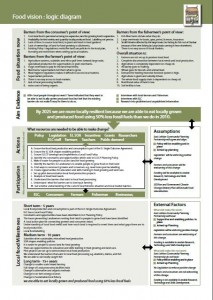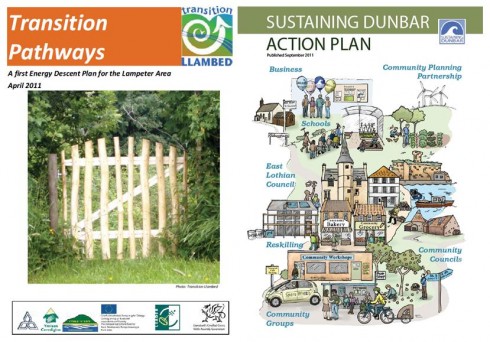14 Dec 2011
Announcing the publication of two new Energy Descent Action Plans!
Like buses, you wait for ages for Energy Descent Action Plans to come along, and then two come along at once. This month sees the publication of two new EDAPs, from Llambed in mid-Wales, and Dunbar in East Lothian, Scotland. For a crash course in EDAPs and a taste of those published thus far, see this ingredient from The Transition Companion. These two high quality pieces of work represent two communities taking the idea of an EDAP and rooting it to their place, their community, their challenges.
 Transition Llambed (Lampeter)’s is titled ‘Transition Pathways: a first Energy Descent Plan for the Lampeter area” (download the pdf here), and was funded by the Rural Development Plan for Wales. It sets its context as being peak oil and climate change, and assesses the current ecological footprint of the area. They did a survey of the area which gave a sense of the levels of awareness of these issues, concluding that peak oil, and the vulnerabilities it raises awareness of, are a better way to engage people than climate change. It sets out a vision for the area that emerged from a series of workshops that were run as part of the process of creating the plan.
Transition Llambed (Lampeter)’s is titled ‘Transition Pathways: a first Energy Descent Plan for the Lampeter area” (download the pdf here), and was funded by the Rural Development Plan for Wales. It sets its context as being peak oil and climate change, and assesses the current ecological footprint of the area. They did a survey of the area which gave a sense of the levels of awareness of these issues, concluding that peak oil, and the vulnerabilities it raises awareness of, are a better way to engage people than climate change. It sets out a vision for the area that emerged from a series of workshops that were run as part of the process of creating the plan.
It then goes on to look in more detail at energy (both how to reduce energy use and the potential of renewable energy generation in the area) and food and agriculture (a kind of “Can Llambed feed itself” type approach), before distilling out concrete suggestions in its closing “Recommendations – a Transition Pathway”. It is a bilingual publication, pick it up and look at it and it’s in English, turn it over and the other way up and it’s in Welsh! It is a powerful vision underpinned by achievable steps, the first of which has already happened (a story you’ll hear more of in tomorrow’s Transition podcast).
 The second one is from Sustaining Dunbar, who are also a Transition initiative. They have all kinds of projects underway, such as the Dunbar Community Bakery which opened recently. The Dunbar EDAP, the ‘Sustaining Dunbar Action Plan’ (download here), is presented as being a draft, but it is a comprehensive document in its own right. Like the Llambed document, it is based on a survey of the local community, in their case, over 1500 Dunbar residents. The surveys showed that local people strongly want more local food, more energy efficient homes, neighbourhoods which are safe and attractive, more walking and cycling and more local jobs. Hardly surprising, but not generally the assumptions that underpin most local authority development plans!
The second one is from Sustaining Dunbar, who are also a Transition initiative. They have all kinds of projects underway, such as the Dunbar Community Bakery which opened recently. The Dunbar EDAP, the ‘Sustaining Dunbar Action Plan’ (download here), is presented as being a draft, but it is a comprehensive document in its own right. Like the Llambed document, it is based on a survey of the local community, in their case, over 1500 Dunbar residents. The surveys showed that local people strongly want more local food, more energy efficient homes, neighbourhoods which are safe and attractive, more walking and cycling and more local jobs. Hardly surprising, but not generally the assumptions that underpin most local authority development plans!
 While the Totnes EDAP ran to 305 pages (as well as being available online), the Dunbar document masters the art of brevity beautifully, running to less than 30 pages. After a page that sets the context, it then sets out its vision for food, energy, transport, health, enterprise, skills and eduction, each of which runs over 3 pages. The second half is then a series of A3 fold-out ‘logic diagrams’ (see the food one, right), a great idea, which set out the situation now in terms of barriers and the current state of play, then the aim for 2025, then who needs to be involved and what they can do, and then milestones to know they are moving in the right direction, short term (5 years), medium term (10 years) and long term (15+ years). For each it sets out how the local Council will have helped and supported the process. I actually think it is quite a brilliant piece of work, and feels like a very do-able document, and a powerful tool for the Transition initiative, the community and the local authority.
While the Totnes EDAP ran to 305 pages (as well as being available online), the Dunbar document masters the art of brevity beautifully, running to less than 30 pages. After a page that sets the context, it then sets out its vision for food, energy, transport, health, enterprise, skills and eduction, each of which runs over 3 pages. The second half is then a series of A3 fold-out ‘logic diagrams’ (see the food one, right), a great idea, which set out the situation now in terms of barriers and the current state of play, then the aim for 2025, then who needs to be involved and what they can do, and then milestones to know they are moving in the right direction, short term (5 years), medium term (10 years) and long term (15+ years). For each it sets out how the local Council will have helped and supported the process. I actually think it is quite a brilliant piece of work, and feels like a very do-able document, and a powerful tool for the Transition initiative, the community and the local authority.
This is what I love about Transition. There are no ‘experts’ on how to do an Energy Descent Action Plan, indeed that’s really the whole point, we are all trying to figure this out together, bringing our own skills and insights to this, and rooting the whole thing in our own communities. From the distant days of the Kinsale EDAP, that idea of the need to visualise where we want to get to and to then try and set out how we might actually get there has taken a number of forms. ‘The Transition Companion’ makes the point that an EDAP may not be the best tool for everywhere, that something like the Economic Blueprint work being developed in Totnes, Hereford and Manchester may be a piece of work which better meets a more widely perceived need. It’s all work in progress, but to read these two pieces of work which represent great evolutions in the development of this tool, is very inspiring.

Steve Last
14 Dec 10:45am
Very inspirational and very helpful. For a Transition initiative working out their own way of putting an EDAP together, looking at what others have done really helps.
Transition Town Worthing is currently working on our second draft of an EDAP. One thing we have discussed is the distinction between having a ‘vision document’ and a relevant ‘action plan’. Bringing the two together in a digestable format is quite a feat!
At present we are considering creating a short-ish document along the lines of Dunbar’s EDAP which sets out the vision and some basic outline of how it could be achieved. The idea would be to back this up with a Worthing EDAP website containing a detailed action plan which could be revised on an annual basis. We are also looking at making a 15 minute film about EDAP. In doing this, we’ll be hoping to relate to different audiences.
The other issue is gaining funding to publish a printed version of the EDAP . . . but that’s a whole other discussion.
Anyway, congratulations to Dunbar and Llambed for making this happen and inspiring us all!